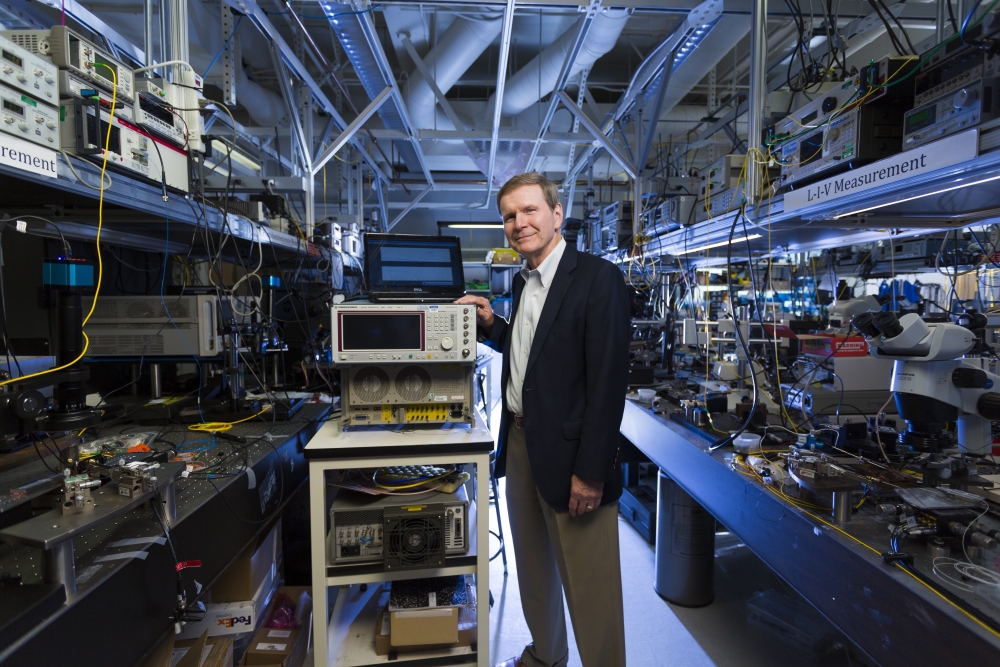
Guiding Light
Where would modern life be without the internet as we know it? When the technology became mainstream in the 1990s, demand for high-speed data transmission exploded, and that need was filled with light — unrivaled for its speed and data capacity. By the end of the 20th century, fiber optic cables and other optical infrastructure had been established around the globe, enabling speed-of-light communications and commerce. Light remains the medium of choice for the next generation of rapid long-distance data transmission.
Among those leading the charge into the era of optical networks was Rod Alferness. With other researchers and colleagues at Bell Labs, he had for years been investigating ways to harness the power of light for telecommunications. Now, as the Richard A. Auhll Professor and Dean of UC Santa Barbara’s College of Engineering, Alferness continues to push for the study and development of optics and photonics technologies to usher in future high-performance, energy-efficient devices and telecommunications infrastructure.
For his work, which includes “basic contributions and leadership in the development of integrated optics, high-speed optical modulation and switching, and configurable WDM networks that have provided significant economic and societal impact,” Alferness has been awarded The Optical Society’s (OSA) highest honor, the 2018 Frederic Ives Medal/Jarus W. Quinn Prize.
“We are tremendously proud that Dean Alferness has received the highest award from The Optical Society for his leadership in integrated optics and optical switching technology and architecture,” remarked UC Santa Barbara Chancellor Henry T. Yang. “Recognition by one’s peers is especially meaningful and speaks to Rod’s reputation within his field. This accolade honors not only him, but also our institution.”
“I am humbled and honored to receive the 2018 Frederic Ives Medal/Jarus W. Quinn Prize from OSA, the society and community that has been my professional home for nearly 45 years,” Alferness said. “My thanks to the OSA Board of Directors, the Awards and Selection Committees, those who supported my nomination and my many collaborators.”
World renowned for his work on integrated-optic devices and optical switching technology and architecture, Alferness is perhaps best known in the technology of his field for his efforts in the realm of wavelength-division-multiplexed (WDM) optical networks, a technology that enables several signals to be carried over a single optical fiber via different wavelengths. His research, according to OSA, led to the “early development of titanium diffused lithium niobate waveguide modulators which are now deployed as the high-speed signal-encoding engine in fiber optic transmission systems around the world.”
Alferness is known also for his leadership in the industry of optics and photonics, having spent much of the early part of his professional career heading research efforts at Bell Labs. Among his most significant early accomplishments is his leadership in the five-year, DARPA-funded MONET project — an experiment that connected six U.S. government agencies in Washington, D.C., via a transparent optical network — which ultimately proved the practicability of such networks. Alferness would go on to lead even larger groups and more expansive efforts as senior vice president of research at Bell Labs’ later incarnations, including parent company Lucent Technologies and at Alcatel-Lucent, eventually becoming chief scientist at Bell Labs/Alcatel-Lucent before joining UC Santa Barbara in 2011.
“Rod is not only smart and knows what to do technically, but he’s also likeable and knows how to influence people,” said Larry Coldren, emeritus professor in the Department of Electrical and Computer Engineering at UC Santa Barbara, and Alferness’ contemporary at Bell Labs. “You don’t see many people who win major tech awards and also rise to the top of organizations like Bell Labs and Lucent Technologies, and to prominence in professional societies. When you have a lot of irons in the fire like that, it’s easy to slack off on one or two of them, but Rod was able to manage all of them well.”
At UC Santa Barbara, Alferness continues his work, helping to enable research and development of the next generation of integrated optics and photonics devices, which hold the promise of state-of-the-art performance and improved energy efficiency for an increasingly data-dependent world. His efforts have resulted in the establishment of UC Santa Barbara as a hub for AIM Photonics, a federal and state engineering technology consortium dedicated to advancing the technology and manufacturing of integrated silicon photonics, as well as to the development of the highly skilled workforce necessary to support the emerging industry.
Alferness is a member of the National Academy of Engineering and a Fellow of OSA and the Institute of Electrical and Electronics Engineers (IEEE). He served as OSA president in 2008 and as a member of the OSA board of directors from 2001 to 2003. He also was president of the IEEE Lasers and Electro-optics Society (now Photonics Society) in 1997. His work and research have earned him numerous awards throughout his career, including the OSA’s Robert E. Hopkins Leadership Award in 2010, the IEEE Millennium Award and the IEEE Photonics Award.
“Rod’s visionary leadership and work in network architecture development has helped bring the internet to every corner of the world, affecting the day-to-day lives of billions of people and having a huge economic and societal impact,” said Liz Rogan, CEO of The Optical Society. “He is an active member in the optics and photonics community, and has volunteered his time to serve in leadership positions for research journals, technical conferences and scientific societies, including The Optical Society. He’s an outstanding scientist, mentor and collaborator.”



